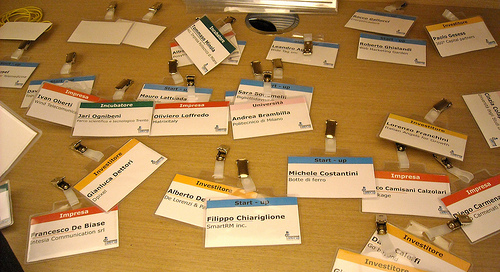|
|
|
Thursday, June 19th, 2014
 Innovation isn’t nearly as mind-boggling today when compared to what startups were doing in the late Seventies/early Eighties when I started working with them. Innovation isn’t nearly as mind-boggling today when compared to what startups were doing in the late Seventies/early Eighties when I started working with them.
That’s not surprising when you consider who gets funded these days.
A recent Reuters report found that the majority of Silicon Valley startup founders that receive Series A funding come from the same pedigreed cohort: either they previously worked at a large, well-known tech firm, a well-connected smaller tech company, they previously created a successful startup, or they come from one of three universities—Stanford, Harvard, or MIT.
Not surprising when you consider the attitude of Valley stalwarts like Paul Graham of Y Combinator, who publically stated that he would be unlikely to fund someone with a strong accent or a woman.
It’s been 15 years since I first wrote about the proclivity of managers to hire people like themselves and more over the years showing it leads to homophily and the negative impact that has on a company.
It seems it’s no different for investors.
They are funding people like themselves who were raised, educated and worked along paths similar to their own who they either know or are introduced to them by a friend.
“Like a lot of the investments [Instacart] that have come our way, a friend of a friend talked to us about it, and told us about it, and encouraged the founder and the CEO to come and chat with us. One thing led to another.” –Sequoia partner Mike Moritz
When you fund from a homogenous group, no matter where they are, creativity and innovation are watered down, because those groups tend to be insular and badly interbred talking mostly to each other.
If you’re fishing from a pond of rich white guys, you’re only going to get ideas that address the needs of rich white guys.
AKA, people like themselves.
Flickr image credit: HikingArtist
Posted in Entrepreneurs, Innovation | No Comments »
Friday, June 13th, 2014
A Friday series exploring Startups and the people who make them go. Read all If the Shoe Fits posts here
 Yesterday we looked at content problems associated with over-familiarity with your products/services and that same over-familiarity can weaken your investor pitch. Yesterday we looked at content problems associated with over-familiarity with your products/services and that same over-familiarity can weaken your investor pitch.
Investors are similar to customers in terms of what they want to know—the difference is viewpoint.
- Where customers want to know what your product/service will do to solve their problem, investors want to know how many have the problem, in other words, how large is the market.
- Customers don’t care about your technology/IP; neither do investors other than to be sure that it is unique and protected, i.e., patented or, at least, patent pending.
- Customers love it when you save them something—money, time, effort—investors love it when you make them something— money.
These days investors are far more focused on “how will you make money,” as opposed to “how will you acquire users.”
This is especially true if you are pitching a web service.
Bottom line; talk tech to the people you hang with, talk money and market to your investors.
Image credit: HikingArtist
Posted in Communication, If the Shoe Fits | No Comments »
Friday, October 11th, 2013
Friday series exploring Startups and the people who make them go. Read all If the Shoe Fits posts here
 As a founder you As a founder you
- identified a market itch;
- crafted a way to scratch it that will delight and de-stress;
- polished the vision so people would get it;
- wowed investors to get funding;
- hired the best talent you could find; and
- worked your tail off building them into a team.
But deep down you believe that teamwork is actually a lot of people doing what you say.
What are your odds for success?
Image credit: HikingArtist
Posted in If the Shoe Fits | No Comments »
Thursday, September 26th, 2013
 Hey entrepreneurs, you heard it here from a founder a year before another founder said it in Fast Company. Hey entrepreneurs, you heard it here from a founder a year before another founder said it in Fast Company.
“It” is the time you waste at so many of the events dedicated to startups and the personalities that populate the entrepreneurial ecosystem.
Networking is presented as the great equalizer; providing situations that are supposed to bridge the chasm faced by new founders and those with well-connected Rolodexes.
But believing that is in the same league as believing in Santa Clause, the Easter Bunny, the Tooth Fairy or the Silicon Valley Meritocracy.
There is no way to minimize the intensity and energy—mental, physical and psychical—involved in founding and building a company; the most likely result of adding networking to the schedule is faster burnout and more damage to your other relationships.
One of the most important skills a founder (or anyone) needs is the ability to prioritize.
To that end, skip the networking and at least 70% of the time you spend on social media and spend it on high ROI actions, including time with family and friends.
You’ll be glad you did.
Flickr image credit: David Orban
Posted in Entrepreneurs | No Comments »
Thursday, September 12th, 2013
 Do you love technology? Do you long for or live on technology’s bleeding edge? Do you love technology? Do you long for or live on technology’s bleeding edge?
Which comes first in your mind, the technology or the problem it addresses?
Too many entrepreneurs’ focus is 80/20—80% technology and 20% problem.
“To me, the computer is just another tool. “It’s like a pen. You have to have a pen, and to know penmanship, but neither will write the book for you. —Red Burns, the “godmother of Silicon Alley” and head of NYU’s Interactive Telecommunications Program.
The problem is the book and the book is what you’re selling.
Your buyers/customers/users don’t care about the technology—at best they won’t notice it; at worst they can ignore it.
They will care about the book; about the story it tells and the experience it offers.
It is the book they will pay for—not the technology.
And it is the book that others will invest in.
Flickr image credit: brewbooks
Posted in Entrepreneurs | No Comments »
Thursday, July 25th, 2013
 I attended the Founder’s Showcase last Wednesday, and found it tremendously interesting from several perspectives. As a founder who has started several companies, of which a couple have been successful, it is really interesting to see how the startup and funding environment has changed. I attended the Founder’s Showcase last Wednesday, and found it tremendously interesting from several perspectives. As a founder who has started several companies, of which a couple have been successful, it is really interesting to see how the startup and funding environment has changed.
The basic format of the Showcase is that companies are selected to pitch to a panel of VCs who then provide them with feedback and advice after having had a chance to ask questions after the pitch. Just hearing the feedback from the panel was very interesting, but also to see the different types of companies that were being pitched. There are a lot of very interesting startups out there…
After sitting through a day of pitches, feedback and interacting with other founders, my main takeaway is that things are getting a lot harder out there for founders who are not well connected in the Silicon Valley environment. There are a plethora of good companies out there that have created interesting businesses and technologies.
To get funding today, it is not enough to have an idea. It seems that what is required is to have removed a significant portion of the risk factors (technology risk, development risk, team risk, market risk and business model risk) from the venture to get an investment from an Angel or VC.
Professional and semi-professional investors (VCs and Angels) have so many deals to choose from that, of course, they will choose the ones that will bring the highest potential return. And this has a strong correlation with low risk and rapid turnaround to the next funding round. Having a completed product and some customer traction implies that much of the risk has been assessed and surpassed, making an investment very attractive. If you don’t have a product and paying customers, know that this is what you are competing against.
Some time ago, it was easier to get funding based on an idea or a prototype, but this seems to no longer be the case in the majority of companies. So founders have to be willing to sacrifice all the way to product and customers before they receive funding.
Another main takeaway from the Founder’s Showcase was the glaring lack of companies doing deeply technological things.
Most of the businesses presenting were essentially new business models with at web/app frontend for a particular industry segment. Almost none of the companies were working on difficult technological innovations.
But speculation as to why this is must be left for a future post.
KG Charles-Harris is CEO of Emanio and a special contributor to MAPping Company Success.
Posted in Entrepreneurs | No Comments »
Friday, June 28th, 2013
A Friday series exploring Startups and the people who make them go. Read all If the Shoe Fits posts here
 Who should make money when you finally cash out? Who should make money when you finally cash out?
Most commentary I see talks about what investors and founders walk away with, but what about the rest of the team?
In an interview, Steve Blank addresses this in terms of the impact on valuation and cashing out after a large investment and how it affects what founders receive, but not its effect on the team.
If the founders walk away with a few million each after the investors take their 3-5X return, what will be left for your people?
Those are the people who made the company successful enough to be bought in the first place.
Most of you will agree that the great majority of startups will not have exits similar to Facebook or Google.
Knowing that, it is your responsibility to honor the social contract you made with your employees, when they traded their compensation for equity in your startup.
Therefore, it is of paramount importance for founders to never lose sight of the numbers; the more investment you take the lower your team’s return when the company is acquired.
Image credit: HikingArtist
Posted in Entrepreneurs, How Stupid Can You Get | No Comments »
Thursday, May 2nd, 2013
 I’ve worked for years with the tech world, particularly startups and young/growing companies mostly run by guys. I’ve worked for years with the tech world, particularly startups and young/growing companies mostly run by guys.
Too often by guys who know it all and/or have little use for wisdom that comes from outside the tech world.
What I tell them is that wisdom comes from everywhere and every level and if they plan to succeed they had better open their minds along with their ears.
What can you learn from an entrepreneur who sells dog food?
A hell of a lot, actually.
Jen Guzman is C.E.O. of Stella & Chewy’s, which sold $8 million worth of organic veggie/raw meat frozen or freeze-dried dog and cat food nationally in 2010 and making it number 424 on the Inc. 5000 in 2011.
Eight million dollars isn’t chickenfeed and I know of no business of any size that wouldn’t kill for comparable testimonials.
Here are three major (IMO) points that any founder would do well to remember.
The right candidate isn’t always a star or the strongest or possess the hottest skills.
The right one is the one who fits best.
I try to hire the best person for what the organization needs, and who can fit into the culture, rather than just hiring the person with the strongest résumé.
These are great questions to ask a candidate, but paraphrased, they are also great questions for investors to ask an entrepreneur.
Why do you want this job? Why do you think you would be good at this job? And what do you think are the five most important qualities or things that you need to be good at this job?
Guzman came from private equity where one of her jobs was assessing potential CEOs.
I looked for people who could explain their business and how they were going to succeed in simple terms, as in: “This is my business model. This is why it works. This is what I think we’re going to achieve next year, and this is how we’re going to do it.” Someone who can boil it down to something very simple, to me, really has their arms around their business. If it’s too complex, how are their employees going to follow it?
The key here is “simple;” a term often seen as offensive when used in conjunction with any one, let alone all, of her questions.
Out of the hundreds of entrepreneurs I’ve talked with over the years maybe a third of them could respond well to these questions.
Be sure you are one of them.
Flickr image credit: Stella & Chewy’s
Posted in Entrepreneurs, Hiring | 1 Comment »
Friday, April 12th, 2013
A Friday series exploring Startups and the people who make them go. Read all If the Shoe Fits posts here
 These days any talk about luck is considered heresy. These days any talk about luck is considered heresy.
But there is such a thing.
Malcolm Gladwell understands the role luck plays and explains it in Outliers: The Story of Success.
A woman I know said, “You can be the best parent in the world, but raising great kids still requires a good dose of luck.”
Nolan Bushnell once said, “Don’t mistake good luck for good management.”
It’s luck when you bump into an investor having coffee with both the time and the inclination to listen; it’s hard work and being prepared that doesn’t waste the opportunity.
When managing people, process or circumstances, you can’t count on luck, but you also can’t ignore it.
And you shouldn’t try to take credit for it.
Image credit: HikingArtist
Posted in Entrepreneurs, If the Shoe Fits | No Comments »
Friday, March 1st, 2013
A Friday series exploring Startups and the people who make them go. Read all If the Shoe Fits posts here
Infographics are all the rage.
Done well, they present large amounts of information in a fast, graphic manner for today’s visually-addicted populace that can’t be bothered to read text.
VentureBeat provides a great example.
Did you know?
The average angel is 47 years old, makes $90,000 a year, invests in one out of every 10 deals he sees, shovels $37,000 into each deal, and lives in California.
Enough writing? Here is VB’s graphic explanation.

Image credit: HikingArtist
Infographic credit: VentureBeat
Posted in Entrepreneurs, If the Shoe Fits | No Comments »
|
 Subscribe to
Subscribe to
MAPping Company Success
About Miki 
Clarify your exec summary, website, etc.
Have a quick question or just want to chat? Feel free to write or call me at 360.335.8054
The 12 Ingredients of a Fillable Req
CheatSheet for InterviewERS
CheatSheet for InterviewEEs™
Give your mind a rest. Here are 4 quick ways to get rid of kinks, break a logjam or juice your creativity!
Creative mousing
Bubblewrap!
Animal innovation
Brain teaser
The latest disaster is here at home; donate to the East Coast recovery efforts now!
Text REDCROSS to 90999 to make a $10 donation or call 00.733.2767. $10 really really does make a difference and you'll never miss it.
And always donate what you can whenever you can
The following accept cash and in-kind donations: Doctors Without Borders, UNICEF, Red Cross, World Food Program, Save the Children
*/
?>About Miki
About KG
Clarify your exec summary, website, marketing collateral, etc.
Have a question or just want to chat @ no cost? Feel free to write
Download useful assistance now.
Entrepreneurs face difficulties that are hard for most people to imagine, let alone understand. You can find anonymous help and connections that do understand at 7 cups of tea.
Crises never end.
$10 really does make a difference and you’ll never miss it,
while $10 a month has exponential power.
Always donate what you can whenever you can.
The following accept cash and in-kind donations:
|
 Innovation isn’t nearly as mind-boggling today when compared to what startups were doing in the late Seventies/early Eighties when I started working with them.
Innovation isn’t nearly as mind-boggling today when compared to what startups were doing in the late Seventies/early Eighties when I started working with them.





 Do you love technology? Do you long for or live on technology’s bleeding edge?
Do you love technology? Do you long for or live on technology’s bleeding edge? I attended the
I attended the  I’ve worked for years with the tech world, particularly startups and young/growing companies mostly run by guys.
I’ve worked for years with the tech world, particularly startups and young/growing companies mostly run by guys.

